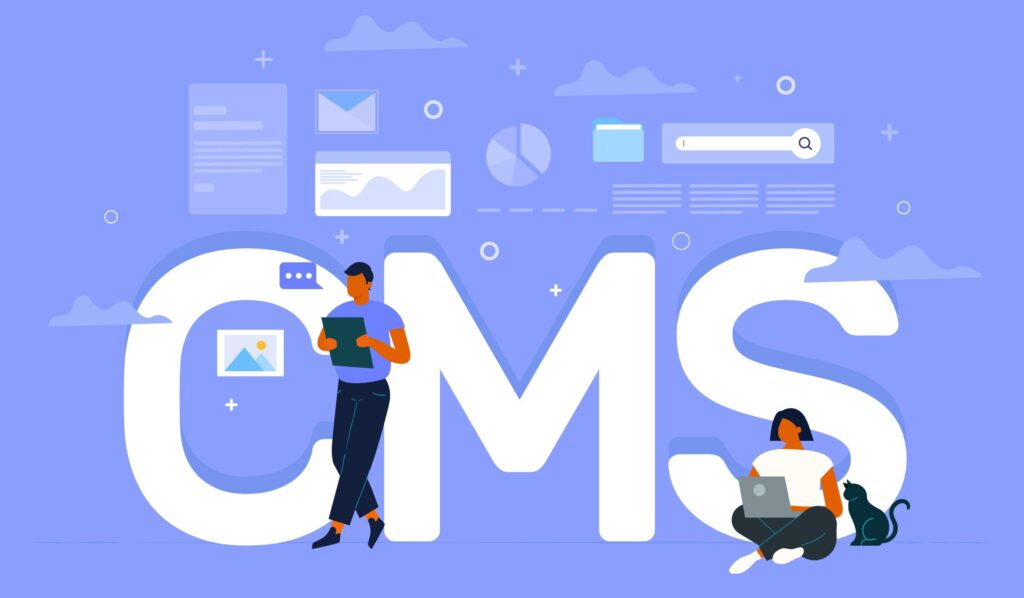If you’re passionate about creating, managing, and delivering content online, you’ve probably heard of the term Content Management System (CMS). But what exactly is it, and why does it matter for website creators and businesses alike? In this in-depth guide, we’ll break down the basics of “what is CMS system”, explore how it works, and why it’s a game-changer for web management. Whether you’re an expert or an enthusiast, you’ll find practical insights and unique perspectives that you won’t find elsewhere.
What is a Content Management System (CMS)?
A Content Management System (CMS) is essentially the backbone of any modern website. It allows users to manage digital content—text, images, multimedia—without needing in-depth coding knowledge. At its core, a CMS separates the content (the text and media) from the design (the website’s layout and visual elements), making website management approachable for anyone.
Historically, building and managing websites required web developers to write extensive lines of code. This often meant that business owners or non-technical individuals would need to hire a developer just to make simple changes, like updating blog posts or changing images. CMS platforms revolutionized this process by offering an intuitive interface where even non-technical users can manage their websites efficiently.
There are countless CMS platforms available today, each tailored to different needs:
WordPress: Powers over 40% of the web and is highly flexible, from simple blogs to complex eCommerce sites.
Joomla: A versatile CMS, offering more complexity than WordPress but less daunting than Drupal.
Drupal: A robust solution for developers and large enterprises looking for high customization and security.
Shopify and Magento: Specifically built for managing online stores, these platforms come with tools for managing inventory, payments, and customer relationships.
How Does a CMS System Work?
A CMS simplifies the technical side of website management by offering both a front-end and a back-end:
The front-end is the visible part of your website that visitors interact with. It’s where your content is presented, and styled according to the chosen template or theme.
The back-end is the “behind the scenes” portion where you manage your content, users, settings, and more. Accessed through a login page, this interface is designed to be simple enough for non-technical users, yet robust enough to offer powerful features for experts.
Here’s a simple breakdown of how a CMS works:
Content Editing: You use the CMS’s editor to create and manage posts, pages, or any type of content. This editor usually includes tools to format text, upload images, and embed media (like videos or social posts).
Database Management: Behind the scenes, the CMS stores your content in a database. When a visitor navigates to a page, the CMS fetches the relevant content from the database and displays it in the format you’ve chosen.
Website Building: Without writing any code, you can customize your site’s layout, fonts, and colors through the CMS’s design interface. Platforms like WordPress and Joomla make this possible through easy-to-use themes and page builders.
Media Library: Most CMS platforms come with a built-in media library where you can upload, organize, and manage images, videos, and audio files. This is especially useful for businesses or blogs that rely on rich visual content.
Key Features of a CMS Systems
A CMS isn’t just about creating content; it’s about managing it efficiently. Most CMS platforms provide features that make it easy to control every aspect of your website without diving into code. Below are some expanded key features that make a CMS an essential tool:
User-Friendly Interface: Modern CMS platforms offer a what-you-see-is-what-you-get (WYSIWYG) interface. This is a game-changer because you can format text, add multimedia, and organize content blocks by simply dragging and dropping elements. It’s as easy as using a word processor like Microsoft Word, making it accessible even for non-tech-savvy users.
Templates and Themes: One of the most attractive aspects of CMS platforms is the availability of customizable templates and themes. Whether you’re building a personal blog or a corporate website, these themes provide you with a professional design without needing a web designer. Premium themes often come with advanced customization options, allowing you to tweak colors, fonts, and layouts to match your brand identity.
Plugins and Extensions: A CMS is like a smartphone—its base functions can be enhanced with plugins or extensions. Plugins add specific features to your website, such as SEO optimization tools, eCommerce functionality, or social media integrations. For example, the Yoast SEO plugin for WordPress is widely used to help websites rank better on search engines by optimizing content for keywords, readability, and metadata.
Scalability: Many CMS platforms, especially WordPress and Drupal, can handle websites ranging from small personal blogs to large-scale corporate websites with millions of monthly visitors. As your business grows, you can add more features and manage a larger content database without the need to overhaul the entire system.
Content Scheduling: If you’re running a blog, managing a news site, or updating product pages regularly, content scheduling is an invaluable feature. You can write your content in advance and schedule it to be published at specific times, which helps in maintaining a steady flow of new material for your audience.
The Different Types of CMS Platforms
Content Management Systems come in various forms, each catering to specific user needs. Understanding these types can help you choose the best platform for your project:
Traditional CMS: This type, also known as a coupled CMS, has both the back-end and front-end integrated into a single system. The back-end is where you manage content, and the front-end is where it’s displayed. WordPress and Joomla are examples of traditional CMS platforms. They are ideal for users who want full control over content and presentation without delving into complex coding.
Headless CMS: A headless CMS decouples the back-end from the front-end. The CMS only handles content management, and you can use any technology you want to display the content. This type is popular among developers who want to use modern front-end frameworks like React, Angular, or Vue.js. For instance, Contentful and Strapi are popular headless CMS platforms. Headless CMSs are particularly beneficial for businesses that require omnichannel content delivery across web, mobile, and IoT devices.
eCommerce CMS: Platforms like Magento, Shopify, and BigCommerce are built specifically for online stores. These platforms include features for managing product catalogs, processing payments, tracking inventory, and handling customer data. An eCommerce CMS integrates all these functions, allowing businesses to create seamless shopping experiences without extensive coding.
Why use CMS software?
If you’re still on the fence about whether to use a CMS system, here are a few compelling reasons why it might be the right choice:
No Technical Expertise Required: You don’t need to know HTML, CSS, or JavaScript to build a professional-looking website. Most CMS platforms provide user-friendly editors that allow you to create content just like you would in a word processor.
Saves Time: A CMS speeds up the process of building and maintaining websites. Instead of writing code, you can choose a template, drag-and-drop content, and publish instantly. This is a huge time-saver for businesses and individuals who don’t have the resources to hire a full-time web developer.
Collaboration Tools: Many CMS platforms enable multiple users to access and contribute to the website. You can assign different roles—like author, editor, and administrator—giving each team member the appropriate level of access. This collaborative environment ensures that tasks can be distributed efficiently.
SEO Optimization: Search engine visibility is critical for online success, and CMS platforms often come equipped with SEO tools that help you optimize content for search engines. Plugins like Yoast SEO provide real-time suggestions for improving your on-page SEO, from keyword usage to metadata.
Security: While no platform is entirely free from risks, CMS platforms are generally secure as long as you keep them updated. For example, WordPress has a vast ecosystem of security plugins like Wordfence or Sucuri, which actively scan for vulnerabilities and offer firewall protection. Additionally, most CMS platforms have active developer communities that regularly release security patches.
Choosing the Right CMS System
Selecting the right CMS is crucial for the long-term success of your website. Here’s how to determine which platform is best suited for you:
Ease of Use: If you’re a beginner, WordPress is likely the best option due to its intuitive design and extensive community support. For users who have some technical knowledge and want more flexibility, Joomla might be a good fit.
Customization and Scalability: If you need extensive customization options, platforms like Drupal or Magento are worth considering. These CMS platforms allow for in-depth control over your website’s functionality, but they also require a steeper learning curve.
Specific Features: If you’re setting up an online store, an eCommerce CMS like Shopify or BigCommerce will provide all the features you need, such as payment gateways, customer relationship management, and inventory tracking.
Practical Insights for CMS Users
If you’re looking to start with a CMS, consider the following practical tips:
Start Small: Even if you’re using a platform like WordPress, which can handle large sites, begin with a simple layout. You can gradually add plugins and features as you get more comfortable with the platform.
Optimize for SEO: Choose a CMS that allows you to optimize your site for search engines. Many CMS platforms offer built-in tools or plugins that simplify the process, like Yoast SEO for WordPress.
Security Matters: Ensure that your CMS is updated regularly. Open-source platforms like WordPress can be vulnerable to security breaches if left outdated. Many CMS platforms offer automatic updates or alerts when new security patches are available.
Conclusion
In conclusion, a Content Management System (CMS) is an invaluable tool for managing a website without the need for coding. Whether you’re a blogger, a small business owner, or running a large enterprise, a CMS can provide you with the flexibility, scalability, and ease of use you need to create and manage digital content efficiently. By understanding your specific requirements and choosing the right CMS, you can unlock the potential of your website and deliver a seamless experience to your users. From WordPress to Drupal and Magento, the CMS landscape offers a wealth of options suited for any skill level and project size.






1 thought on “What is a Content Management System (CMS)? Basic Guide + Definition”
Naturally, any website that has more than 100 pages would definitely need a CMS to lead the edge. You explained it right, and in fact, I personally like your website in several ways; nevertheless, thanks for the effort.